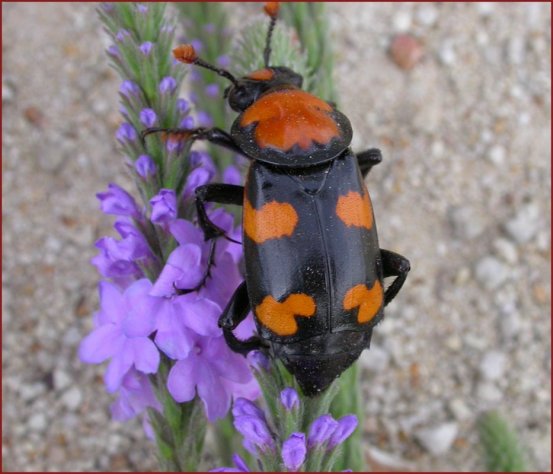Nicrophorus americanus, The American Burying beetle |
|---|
 The American Burying beetle, Nicrophorus americanus, is one of 31 North American species in the family Silphidae, the carrion beetles. It is the largest carrion feeding insect in North America, measuring up to 3 cm. N. americanus can be distinguished from other species in the genus by its solid orange pronotum. Like other , Necrophorus it has black elytra with orange bands. N. americanus originally ranged throughout the eastern United States and adjacent southern Canada. Today it is restricted to isolated patches at the margins of its former range. It can be found in a wide range of habitats, including prairie, scrubland, open woodland and deciduous forests. It is probably the availability of its only food source, carrion in the size range of 50 -700 grams, that limits the distribution of this beetle, rather than any specific habitat requirements or preferences. N. americanus is completely dependent on fresh carrion for its lifecycle, which is what makes it so sensitive to environmental changes. The nocturnal adults are surprisingly adept at finding fresh carcasses. They can detect the body of a mouse dead for only 2 hours from up to 2 miles away. Once a suitable carcass is found, the male and female work together to bury it under a few inches of soil. After burying the carcass, both beetles strip it of fur or feathers and form it into a ball. Eggs are laid in a small hole chewed into the carcass and both parents regurgitate partly digested food for the larvae when they hatch. N. americanus exhibits surprisingly complex parental care behavior, with some similarities to the social Hymenoptera and Isoptera. Larvae are tended by the male and female until pupation and the carcass is constantly kept free of fungus and competing maggots. The parents also cover the carcass in an antibacterial secretion to further limit any competition for their offspring. N. americanus was listed as a federally endangered species in 1989. On the IUCN’s Red List, it has the status of “critically endangered” and the Nature Conservancy lists it as a G1 species, or in danger of global extinction. Currently, there are only a few small populations in undisturbed areas of Arkansas, Massachusetts, Nebraska, Oklahoma, Rhode Island and possibly South Dakota. The Nebraska populations consist of about a thousand individuals, there are a few hundred on Nantucket Island, MA and the exact numbers of the other populations are unknown. N. americanus started its decline in the 1920s and by the 1960s it was gone from its original range east of the Appalachians. Western populations continued to decline to the current remnant status. A combination of factors has contributed to the decline of N. americanus but chief among them is habitat fragmentation. Fragmentation allows for the invasion of edge type mammalian scavengers like skunks, raccoons and opossums which out-compete N. americanus for fresh carcasses. Artificial lights and inbreeding also take their toll. Several tactics are being used to protect and recover N. americanus. Known populations have the protection of ESA and their habitats are safe from development for now. Searches are also underway for new populations. The U.S. Fish and Wildlife Service, in conjunction with Boston University and the Roger Williams Park Zoo of Providence, RI, began to reintroduce the beetles to Nantucket Island, MA in1994 from laboratory populations at BU and RWPZ. So far, reintroductions have been successful with several hundred individuals released to date. |
Resources:
|
Written by: Alex Swanson 2002 Updated 2008. |
Image credit: Doug Backlund, http://pie.midco.net/dougback/ |